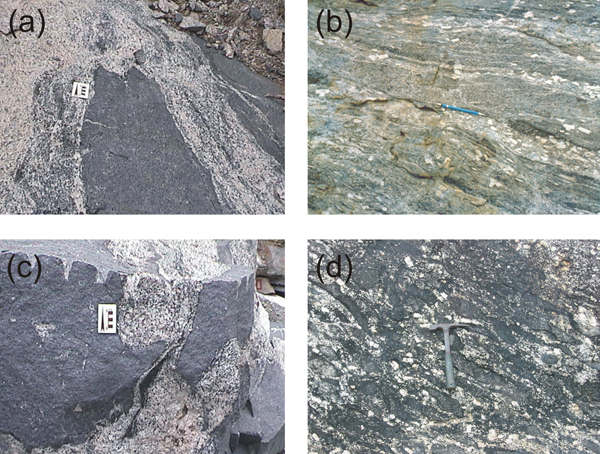Dioritic rocks in the Borborema Province are characterized petrographically by the presence of biotite as a main mafic phase, commonly associated with sub-equal amounts of amphibole, and rare clinopyroxene. Most modal compositions plot in the quartz-diorite and quartz-monzodiorite fields. These rocks are associated with coarse-grained, porphyritic high-K calc-alkalic quartz monzonites to granites that form numerous composite plutons up to 2000 km2 in area in the central and northeastern portions of the province (Figure 1; Mariano & Sial, 1990; Jardim de Sá, 1994; Neves & Mariano, 1997; Ferreira et al., 1998; Neves et al., 2000). Commingling features are widespread, indicating that dioritic and granitic magmas coexisted. The main features are: gradational contacts (Figure 2a), locally characterized by alternation of felsic and mafic bands giving rise to net-veined complexes which resemble stromatic structures of migmatites (Figure 2b); lobate and cuspate contacts (Figure 2c); and the frequent entrapment of K-feldspar megacrysts by diorites (Figure 2a and b). Abundant aligned elongated dioritic enclaves may represent disrupted syn-plutonic dikes (Figure 2d). Late fracture-controlled dioritic dikes free of K-feldspar megacrysts attest to recurrence of dioritic magmatism. The diorites generally represents 5 to10 % of the outcrop area of the plutons, but in a few cases they may reach up to 40 %.
Figure 2. Field relationships

Field relationships between felsic porphyritic quartz monzonite to granite and diorites in the Borborema Province.
Gradational contact between large dioritic enclaves and granite developing hybrid bands;
net-veined complex similar to stromatic structures of migmatites;
three-dimensional view of irregular lobate and cuspate contacts indicating coexistence in magmatic stage; and
swarm of aligned elongated dioritic enclaves, suggesting disrupted syn-plutonic dikes.
Plutons of the diorite-granite association intrude low- to medium-pressure, high-temperature metamorphic rocks and are associated with transcurrent shear zones (Figure 1; Vauchez et al., 1995; Neves et al., 1996; Archanjo et al., 2002; Weinberg et al., 2004). Available zircon U-Pb and 206Pb-207Pb ages range from 592 to 579 Ma (Leterrier et al., 1994; Guimarães et al., 1998; Almeida et al., 2002; Brito Neves et al., 2003; Neves et al., 2004). Intrusion occurred when the Brasiliano orogeny was well-advanced, post-dating its beginning by 40-60 Ma (see review in Neves, 2003), indicating the intracontinental nature of plutons and associated shear zones.